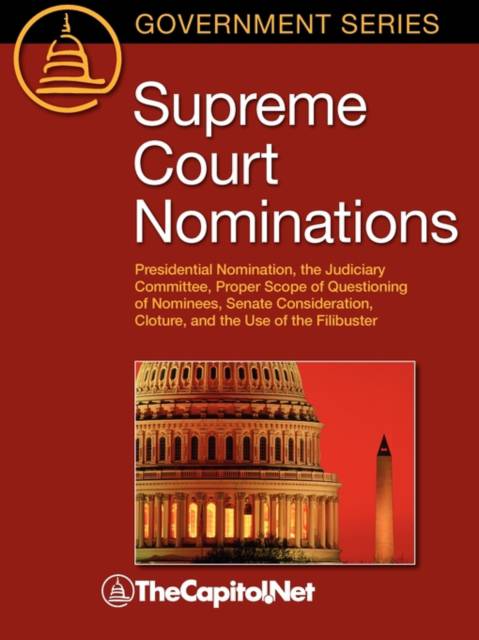
- Retrait gratuit dans votre magasin Club
- 7.000.000 titres dans notre catalogue
- Payer en toute sécurité
- Toujours un magasin près de chez vous
- Retrait gratuit dans votre magasin Club
- 7.000.000 titres dans notre catalogue
- Payer en toute sécurité
- Toujours un magasin près de chez vous
Supreme Court Nominations
Presidential Nomination, the Judiciary Committee, Proper Scope of Questioning of Nominees, Senate Consideration, Clotu
Denis Steven Rutkus, Elizabeth RybickiDescription
Part of the Government Series, from TheCapitol.Net
The procedure for appointing a Supreme Court Justice is provided for by the Constitution in only a few words. The "Appointments Clause" (Article II, Section 2, clause 2) states that the President "shall nominate, and by and with the Advise and Consent of the Senate, shall appoint Judges of the supreme Court."
The process of appointing Justices has undergone changes over two centuries, but its most basic feature--the sharing of power between the President and Senate--has remained unchanged. To receive lifetime appointment to the Court, a candidate must first be nominated by the President and then confirmed by the Senate. Although not mentioned in the Constitution, an important role is played midway in the process (after the President selects, but before the Senate considers) by the Senate Judiciary Committee. Since the end of the Civil War, almost every Supreme Court nomination received by the Senate has first been referred to and considered by the Judiciary Committee before being acted on by the Senate as a whole.
This book explores the appointment process--from Presidential announcement, Judiciary Committee investigation, confirmation hearings, vote, and report to the Senate, through Senate debate and vote on the nomination.
Summary of Contents
Ch. 1. Supreme Court Appointment Process: Roles of the President, Judiciary Committee, and Senate, by Denis Steven Rutkus
Ch. 2. Senate Consideration of Presidential Nominations: Committee and Floor Procedure, by Elizabeth Rybicki
Ch. 3. Evolution of the Senate's Role in the Nomination and Confirmation Process: A Brief History, by Betsy Palmer
Ch. 4. Proper Scope of Questioning of Supreme Court Nominees: The Current [2005] Debate," by Denis Steven Rutkus
Ch. 5. Constitutionality of a Senate Filibuster of a Judicial Nomination, by Todd Tatelman
Ch. 6. Cloture Attempts on Nominations, by Richard S. Beth and Betsy Palmer
Ch. 7. Changing Senate Rules or Procedures: The 'Constitutional' or 'Nuclear' Option, by Betsy Palmer
Ch. 8. 'Entrenchment' of Senate Procedure and the 'Nuclear Option' for Change: Possible Proceedings and Their Implications, by Richard S. Beth
Ch. 9. "Consideration and Debate on the Senate Floor: Filibusters," "Cloture in Senate Floor Proceedings," "Steps to Invoke Cloture," and "Senate Procedures under Cloture," Sections 8.210-8.232, from the Congressional Deskbook, by Michael Koempel and Judy Schneider
Ch. 10. "Congress and the Executive: Appointments" and "Confirmation Procedure," Sections 10.81-10.81 from the Congressional Deskbook, by Michael Koempel and Judy Schneider
Ch. 11. "Nominations to Federal Courts" and "Gathering Information on a Judicial Nominee," Sections 10.121-10.122 from the Congressional Deskbook, by Michael Koempel and Judy Schneider
Ch. 12. Other Resources
Complete Table of Contents at www.TCNSCN.com
Spécifications
Parties prenantes
- Auteur(s) :
- Editeur:
Contenu
- Nombre de pages :
- 208
- Langue:
- Anglais
- Collection :
Caractéristiques
- EAN:
- 9781587331589
- Date de parution :
- 23-06-09
- Format:
- Livre broché
- Format numérique:
- Trade paperback (VS)
- Dimensions :
- 210 mm x 279 mm
- Poids :
- 489 g







